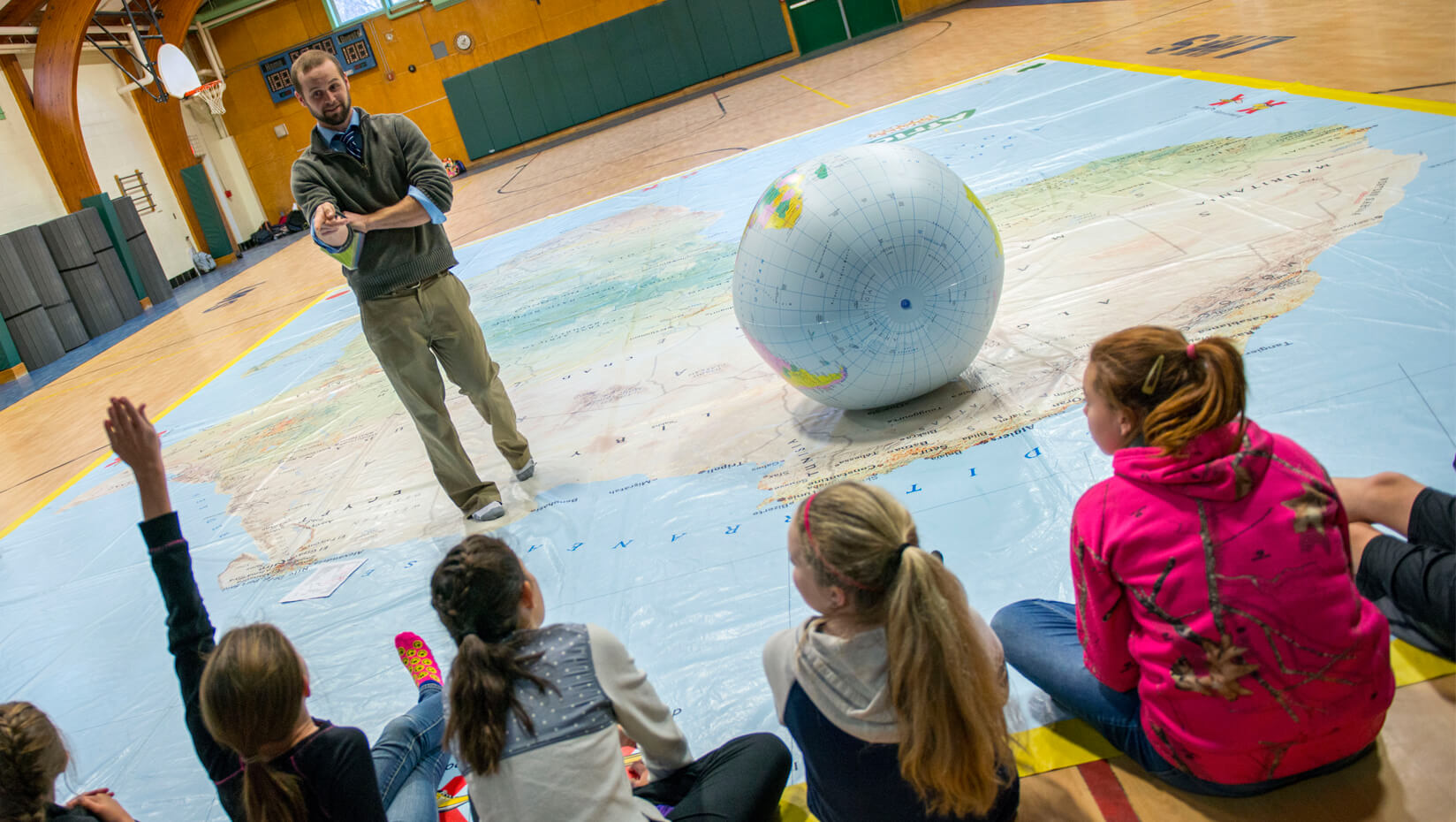
UMaine professor uses giant map to teach middle school students about African geography, culture
Patrick Womac takes off his shoes and steps onto the huge map of Africa covering half the gym floor at Old Town’s Leonard Middle School. Womac, an assistant professor of curriculum, assessment and instruction at the University of Maine, stands on Libya as he leads a group of seventh graders in discussion.
“How many people do you think live in the United States?” he asks the students, sitting around the edge of the map with their shoes off, as well.
“Ten million,” yells out one student.
“Twenty million,” says another.
“Those are good guesses,” says Womac. “But actually, there are 320 million people in this country.”
“Africa,” he continues, “has over a billion people who live on this one continent. Fifty-four countries and they’re all very different from each other.”
The map is part of National Geographic’s Giant Traveling Maps program, and was first featured as a standard pullout in the September 2005 issue of National Geographic magazine, a special edition devoted to Africa.
The giant version measures 26 feet by 35 feet, and is made from a thin, vinyl material. Students and teachers must remove their shoes and not use writing utensils around the map to prevent damage to its surface. It comes with a box full of lessons and activities that can be used to teach everything from geography to climate to animals to cultural and economic facts.
Womac, whose specialty is social studies education, was able to bring the map to Leonard Middle School for Geography Awareness Week, which National Geographic started in 1987. He says one of his goals is to show students the diversity of the African continent.
“Most of what I’ve been trying to do is break stereotypes and misconceptions,” he says. “Africa is not just a big desert or jungle. Africans don’t all live in huts. This is not a primitive place like the media so often suggest.”
In fact, he says there’s great innovation occurring throughout Africa in biology, engineering and many other fields. He adds that American culture, economy and politics have been influenced by Africa for centuries, and it’s becoming increasingly important to understand those complex relationships.
Students will have a chance to learn more about African life on Tuesday, Nov. 24, when Leonard Middle School hosts an African Culture Fair. Performers will include Namory Keita, a drummer from Guinea who currently lives in Portland, and Camden-based African dancer Denyse Robinson. Members of the UMaine Multicultural Center from Africa also will be on hand to give talks, serve food and talk to students about their home countries.
“I wanted to involve people on campus, and the Office of Multicultural Student Life has a mission to promote cultural understanding, and their staff includes individuals who grew up in African countries,” says Womac, who got a small grant from the UMaine Humanities Center to help pay for the cost of renting the map. The College of Education and Human Development paid the balance.
Jody McDonald, who teaches eighth grade social studies at Leonard Middle School, says the giant map is an excellent resource.
“They’re able to see scale much better,” McDonald says of her students. “Plus, they’re a bunch that need to get around and move, and it helps with that.”
Womac’s relationship with the middle school started with another project he’s working on: trying to place some of his UMaine undergrads for a couple hours a week. The map was kind of a bonus, but it’s worked out so well, he’s thinking of expanding it next year.
“This has been a successful trial run. Next year, I’m hoping to do it bigger and better,” he says. “Different continents, more schools, more guest speakers from the community and around the world.”
Contact: Casey Kelly, 207.581.3751
